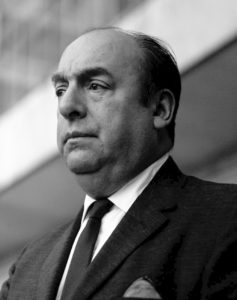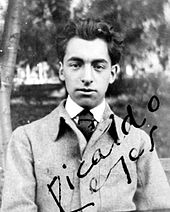 On this day in 1835, opera composer Vincenzo Bellini died in Puteaux, near Paris of acute inflammation of the intestine at the age of 33. Born Vincenzo Salvatore Carmelo Francesco Bellini on 3 November 1801 in Catania, at the time part of the Kingdom of Sicily. His greatest works are I Capuleti ed i Montecchi (1830), La sonnambula (1831), Norma (1831), Beatrice di Tenda (1833), and I puritani (1835). Known for his long-flowing melodic lines, for which he was named “the Swan of Catania”, Bellini was the quintessential composer of bel canto opera. He had a sequence of affairs with married women, including Giuditta Turina. But he resisted any emotional commitment, and never married. When Turina proposed to leave her husband, Bellini bridled: “with so many commitments, such a relationship would be fatal to me“.
On this day in 1835, opera composer Vincenzo Bellini died in Puteaux, near Paris of acute inflammation of the intestine at the age of 33. Born Vincenzo Salvatore Carmelo Francesco Bellini on 3 November 1801 in Catania, at the time part of the Kingdom of Sicily. His greatest works are I Capuleti ed i Montecchi (1830), La sonnambula (1831), Norma (1831), Beatrice di Tenda (1833), and I puritani (1835). Known for his long-flowing melodic lines, for which he was named “the Swan of Catania”, Bellini was the quintessential composer of bel canto opera. He had a sequence of affairs with married women, including Giuditta Turina. But he resisted any emotional commitment, and never married. When Turina proposed to leave her husband, Bellini bridled: “with so many commitments, such a relationship would be fatal to me“.
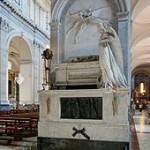 The Final Footprint – Bellini was entombed in Père Lachaise Cemetery, Paris but his remains were removed to the cathedral of Catania in 1876. Catania Cathedral, dedicated to Saint Agatha, is a Roman Catholic cathedral in Catania, Sicily. It was the seat of the Bishops of Catania until 1859, when the diocese was elevated to an archdiocese, and since then has been the seat of the Archbishops of Catania. Bellini’s cenotaph remains in Père Lachaise. The Museo Belliniano housed in the Gravina Cruyllas Palace in Catania preserves memorabilia and scores.
The Final Footprint – Bellini was entombed in Père Lachaise Cemetery, Paris but his remains were removed to the cathedral of Catania in 1876. Catania Cathedral, dedicated to Saint Agatha, is a Roman Catholic cathedral in Catania, Sicily. It was the seat of the Bishops of Catania until 1859, when the diocese was elevated to an archdiocese, and since then has been the seat of the Archbishops of Catania. Bellini’s cenotaph remains in Père Lachaise. The Museo Belliniano housed in the Gravina Cruyllas Palace in Catania preserves memorabilia and scores.
#RIP #OTD in 1939 neurologist and founder of psychoanalysis Sigmund Freud died from a physician assisted overdose of morphine at his home in Hampstead, London, age 83. Cremated remains in “Freud Corner” Golders Green Crematorium, London
#RIP #OTD in 1943 British novelist (Beyond the Rocks, Three Weeks), scriptwriter, Elinor Glyn died at 39 Royal Avenue, Chelsea, London, aged 78. Cremated remains at Golders Green Crematorium, London
On this day in 1973, poet-diplomat and politician Pablo Neruda died in his house in Isla Negra, Santiago, Chile under mysterious circumstances at the age of 69. Born Ricardo Eliécer Neftalí Reyes Basoalto on 12 July 1904 in Parral, Maule Region, Chile. Neruda became known as a poet when he was 13 years old, and wrote in a variety of styles, including surrealist poems, historical epics, overtly political manifestos, a prose autobiography, and passionate love poems such as the ones in his collection Twenty Love Poems and a Song of Despair (1924). He won the Nobel Prize for Literature in 1971.
Neruda occupied many diplomatic positions in various countries during his lifetime and served a term as a Senator for the Chilean Communist Party. When President Gabriel González Videla outlawed communism in Chile in 1948, a warrant was issued for Neruda’s arrest. Friends hid him for months in the basement of a house in the port city of Valparaíso; Neruda escaped through a mountain pass near Maihue Lake into Argentina. Years later, Neruda was a close advisor to Chile’s socialist President Salvador Allende. When Neruda returned to Chile after his Nobel Prize acceptance speech, Allende invited him to read at the Estadio Nacional before 70,000 people.
Neruda was hospitalised with cancer at the time of the coup d’état led by Augusto Pinochet that overthrew Allende’s government, but returned home after a few days when he suspected a doctor of injecting him with an unknown substance for the purpose of murdering him on Pinochet’s orders. Although it was long reported that he died of heart failure, the Interior Ministry of the Chilean government issued a statement in 2015 acknowledging a Ministry document indicating the government’s official position that “it was clearly possible and highly likely” that Neruda was killed as a result of “the intervention of third parties”.
Neruda is often considered the national poet of Chile, and his works have been popular and influential worldwide. The Colombian novelist Gabriel García Márquez once called him “the greatest poet of the 20th century in any language”.
something started in my soul,
fever or forgotten wings,
and I made my own way,
deciphering
that fire
and wrote the first faint line,
faint without substance, pure
nonsense,
pure wisdom,
of someone who knows nothing,
and suddenly I saw
the heavens
unfastened
and open.
From “Poetry”, Memorial de Isla Negra (1964).
Trans. Alastair Reid.
from “Full Woman, Fleshly Apple, Hot Moon”
Full woman, fleshly apple, hot moon,
thick smell of seaweed, crushed mud and light,
what obscure brilliance opens between your columns?
What ancient night does a man touch with his senses?
Loving is a journey with water and with stars,
with smothered air and abrupt storms of flour:
loving is a clash of lightning-bolts
and two bodies defeated by a single drop of honey.
From “Full Woman, Fleshly Apple, Hot Moon”,
Selected Poems translated by Stephen Mitchell (1997)
The Final Footprint
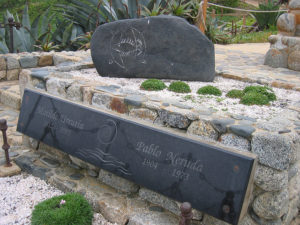 Pinochet, backed by elements of the armed forces, denied permission for Neruda’s funeral to be made a public event, but thousands of grieving Chileans disobeyed the curfew and crowded the streets. The funeral took place amidst a massive police presence, and mourners took advantage of the occasion to protest against the new regime, established just a couple of weeks before. Interment took place on his estate in Isla Negra.
Pinochet, backed by elements of the armed forces, denied permission for Neruda’s funeral to be made a public event, but thousands of grieving Chileans disobeyed the curfew and crowded the streets. The funeral took place amidst a massive police presence, and mourners took advantage of the occasion to protest against the new regime, established just a couple of weeks before. Interment took place on his estate in Isla Negra.
 On this day in 1981, Native Canadian, poet, Academy Award-nominated actor, humanitarian, a chief of the Tsleil-Waututh Nation of Burrard Inlet, Chief Dan George died in Vancouver, British Columbia, age 82. Born Geswanouth Slahhot on 24 July 1899 in Burrard Inlet, British Columbia. I very much enjoyed his performance alongside Clint Eastwood in The Outlaw Josey Wales. His best-known written work is his poem “My Heart Soars.”
On this day in 1981, Native Canadian, poet, Academy Award-nominated actor, humanitarian, a chief of the Tsleil-Waututh Nation of Burrard Inlet, Chief Dan George died in Vancouver, British Columbia, age 82. Born Geswanouth Slahhot on 24 July 1899 in Burrard Inlet, British Columbia. I very much enjoyed his performance alongside Clint Eastwood in The Outlaw Josey Wales. His best-known written work is his poem “My Heart Soars.”
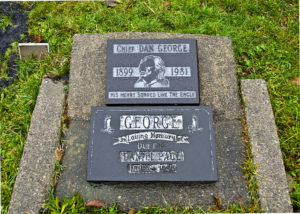 The Final Footprint – George was buried in Burrard Cemetery in North Vancouver, British Columbia. His grave is marked by two flat granite engraved markers on a raised concrete base and a concrete border around his grave. Along with his name and birth and death dates the inscriptions on the markers read: HIS HEART SOARED LIKE THE EAGLE and In Loving Memory of Our Dad Daniel Paul.
The Final Footprint – George was buried in Burrard Cemetery in North Vancouver, British Columbia. His grave is marked by two flat granite engraved markers on a raised concrete base and a concrete border around his grave. Along with his name and birth and death dates the inscriptions on the markers read: HIS HEART SOARED LIKE THE EAGLE and In Loving Memory of Our Dad Daniel Paul.
 On this day in 1987 dancer, choreographer, actor, theatre director, filmmaker Bob Fosse died of a heart attack at George Washington University Hospital, Washington DC, aged 60.
On this day in 1987 dancer, choreographer, actor, theatre director, filmmaker Bob Fosse died of a heart attack at George Washington University Hospital, Washington DC, aged 60.
He directed and choreographed musical works on stage and screen, including the stage musicals The Pajama Game (1954), Damn Yankees (1955), How to Succeed in Business Without Really Trying (1961), Sweet Charity (1966), Pippin (1972), and Chicago (1975). He directed the films Sweet Charity (1969), Cabaret (1972), Lenny (1975), All That Jazz (1979), and Star 80 (1983).
Fosse’s distinctive style of choreography included turned-in knees and “jazz hands”. He is the only person ever to have won Oscar, Emmy, and Tony awards in the same year (1973). He was nominated for four Academy Awards, winning Best Director for Cabaret, and won the Palme D’Or in 1980 for All That Jazz. He won a record eight Tonys for his choreography, as well as one for direction for Pippin.
Fosse married dance partner Mary Ann Niles (1923–1987) on May 3, 1947, in Detroit. In 1952, a year after he divorced Niles, he married dancer Joan McCracken in New York City; this marriage lasted until 1959, when it also ended in divorce.
His third wife was dancer and actress Gwen Verdon, whom he met choreographing Damn Yankees, in which she starred. Fosse’s extramarital affairs put a strain on the marriage and by 1971 they were separated, although they remained legally married until his death in 1987. Verdon never remarried.
Fosse met dancer Ann Reinking during the run of Pippin in 1972. According to Reinking, their romantic relationship ended “toward the end of the run of Dancin‘”.
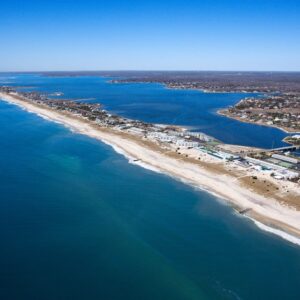 The Final Footprint – Fosse collapsed in Verdon’s arms near the Willard Hotel prior to being taken to the hospital. As he had requested, Verdon scattered his ashes in the Atlantic Ocean off Quogue, Long Island, where Fosse had been living. A month after his passing, Verdon fulfilled Fosse’s request for his friends to “go out and have dinner on me” by hosting a star-studded, celebrity filled evening at Tavern on the Green.
The Final Footprint – Fosse collapsed in Verdon’s arms near the Willard Hotel prior to being taken to the hospital. As he had requested, Verdon scattered his ashes in the Atlantic Ocean off Quogue, Long Island, where Fosse had been living. A month after his passing, Verdon fulfilled Fosse’s request for his friends to “go out and have dinner on me” by hosting a star-studded, celebrity filled evening at Tavern on the Green.
 And on this day in 2020 singer, actress Juliette Gréco died in Ramatuelle, France at the age of 93. Born in Montpellier, France on 7 February 1927. Perhaps her best known songs are “Paris Canaille” (1962, originally sung by Léo Ferré), “La Javanaise” (1963, written by Serge Gainsbourg for Gréco) and “Déshabillez-moi” (1967). She often sang tracks with lyrics written by French poets such as Jacques Prévert and Boris Vian, as well as singers like Jacques Brel and Charles Aznavour. Her 60-year career came to an end in 2015 when she began her last worldwide tour titled “Merci”. As an actress, Gréco played roles in films by French directors such as Jean Cocteau and Jean-Pierre Melville.
And on this day in 2020 singer, actress Juliette Gréco died in Ramatuelle, France at the age of 93. Born in Montpellier, France on 7 February 1927. Perhaps her best known songs are “Paris Canaille” (1962, originally sung by Léo Ferré), “La Javanaise” (1963, written by Serge Gainsbourg for Gréco) and “Déshabillez-moi” (1967). She often sang tracks with lyrics written by French poets such as Jacques Prévert and Boris Vian, as well as singers like Jacques Brel and Charles Aznavour. Her 60-year career came to an end in 2015 when she began her last worldwide tour titled “Merci”. As an actress, Gréco played roles in films by French directors such as Jean Cocteau and Jean-Pierre Melville.
Gréco became a devotee of the bohemian fashion of some intellectuals of post-war France. Duc sent her to attend acting classes given by Solange Sicard. She made her debut in the play Victor ou les Enfants au pouvoir in November 1946 and began to host a radio show dedicated to poetry.
Her friend Jean-Paul Sartre installed her at the Hotel La Louisiane and commented Greco had “millions of poems in her voice”. She was known to many of the writers and artists working in Saint-Germain-des-Prés, such as Albert Camus, Jacques Prévert and Boris Vian, thus gaining the nickname la Muse de l’existentialisme.
Gréco spent the post-Liberation years frequenting the Saint-Germain-des-Prés cafes, immersing herself in political and philosophical bohemian culture. As a regular at music and poetry venues like Le Tabou on Rue Dauphine, she was acquainted with Cocteau, and was given a role in Cocteau’s film Orphée (1950).
In 1949, she began an affair with the American jazz musician Miles Davis. In 1957, they decided to always be just lovers because their careers were in different countries and his fear of damaging her career by being in an interracial relationship. They remained lovers and friends until his death in 1991.
Gréco was married three times, to:
- actor Philippe Lemaire (1953–1956)
- actor Michel Piccoli (1966–1977)
- pianist Gérard Jouannest (1988–2018; his death)
With Lemaire, she had a daughter, Laurence-Marie, born in 1954. Laurence-Marie Lemaire died from cancer in 2016 aged 62.
In the year leading up to his death in January 1949, Gréco was the lover of married racing driver Jean-Pierre Wimille and suffered a miscarriage after his death.
According to Spanish writer Manuel Vicent, Gréco was Camus’s lover. She also was in relationships with French singer Sacha Distel and Hollywood producer Darryl F. Zanuck.
During her affair with Davis, she was also dating U.S. record producer Quincy Jones. According to Jones’ autobiography, Davis was irritated with him for years when he found out.
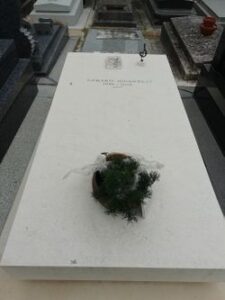 The Final Footprint – Cimetière du Montparnasse, Paris.
The Final Footprint – Cimetière du Montparnasse, Paris.
Have you planned yours yet?
Follow TFF on twitter @RIPTFF

